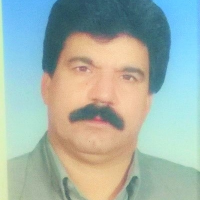Reflect Of Epic in Elhami Kermanshahi's Shahed-Nameh
Author(s):
Article Type:
Research/Original Article (ترویجی)
Abstract:
Introduction
The Iranian religion changed after Islam, but some of their national and religious beliefs remained in the form of mythology and epics in the people's culture, and later appeared in Shahnameh and other texts. Ferdowsi has not seen any conflicts between being a Muslim and Shiite and preserving the ancient glories of the Iranian people and adhering to the national identity, and with his knowledge and intelligence he has achieved a wise balance between the prehistoric Iran culture and the Islamic culture (Afshari, 2000: 30). The most influential religious epic is the Ashura incident that affects Iranian Muslims, whether consciously or unconsciously, they establish a balance between this event and their past culture. This process continues with the Qajar government and the importance they gave to Ta'zieh and religious poems. And many influential Ashuraii poems have been written in this period. This research is an attempt to investigate the reflection of the elements of the national epic of Iran in the epic-religious poem book of Shahednameh by Elhami Kermanshahi, who viewed Imam Hussein's uprising as an epic. Elhami is known as "Hosseini Ferdowsi", and this name is given in the works of his contemporaries and fellow citizens. Writing this religious poem, Elhami is without a doubt one of Ferdowsi's greatest followers. He has beautifully established this proportion between the Iranian Shia, who loves Hussein ibn Ali (AS) with Iranian nationality (ibid: 28). This great poet known as "King of Karbala's Ferdowsi" or "Husseini Ferdowsi" passed away on 1946. He was initially a common man and being inspired to write a Masnavi, is also very considerable. If we do not hesitate about the dream of Mirza Ahmad ibn Rustam and his inspiration to write about the Third Imam of the Shiites (AS), the creation of a work with the epic side and that imitating Hakim Abolqasem Ferdowsi, is highly notable. . As we know, this style has a background in the history of Persian literature. We read the story of the changing nature of poets such as Nasir Khosrow and Sanai, and the inspiration in sleep (whether real or not), and the cutting off of material realities and turning to spiritual realities, but the story of being inspired to write an epic has a low profile and, as far as we know. This again reveals the mystery of the survival of Shahnameh by Ferdowsi, which inspires Iranians in the creation of religious works, both in the dream and in the awakening.
Methodology
The research methodology is descriptive-analytic and based on the library method. After introducing Ferdowsi's style in Shahnameh and the quality of the application of the epic elements of Shahnameh, the reflection of this method in Shahednameh by Elhami Kermanshahi as religious epic is discussed.
Discussion
Elhami Kermanshahi has been very much inspired by Hakim Abulghassem Ferdowsi in writing his poem; As if he had assumed for himself not to leave the scope of Shahnameh and to follow exactly the master of the Tous. One can refer to Elhami as one of Ferdowsi's best and most loyal ambassadors, whether in terms of form and type of literature, or in terms of choosing words and describing epic and battle scenes. In what follows, some of the similarities of Shahednameh and Shahnameh are mentioned: The use of weapons and ammunition: In Shahednameh, like Shahname, we encounter so many cases of referring to weapons used at war. Vocabulary: There are many vocabularies of Shahnameh used in Shahednameh, such as: Dezham, Abnous, Palhang, Badafreh, Angesht, Espahbod, Sandors, Bivar, Koupal, Fetrak, Hozhabr, Khoaligaran, Bargastovan, Khaftan, Bighareh, Bijadeh, Charmeh, … Some of these words have been frequently used in Shahednameh, such as: "Binandeh". This word means "eye" in Shahnameh and although it has become obsolete in Elhami's time, it is used again with a high frequency and with the same meaning. Similie: According to the necessity of poetry and its epic style and description of the battle scenes, beautiful and artistic similies are used, which are more imitative of Shahnameh, and there are, of course, some innovative ones. The followings are some examples: "Be Kerdare Baad", "Daryaye Simab", "Almasgoun", "Kan Bedakhsh", "Rakhshandeh Bargh and Khoroushandeh Bargh", "Daryaye Atash", "Azargashsb", "Baad Damaan", "Shir Dezhagah", "Daryaye Simab", "Ezhdehaye Kalim", "Mahe No", …
Conclusion
Shahednameh or Bagh Ferdows by Elhami Kermanshahi is a long, coherent, poetic narrative of the life of the third Imam of Shiite, Hussen ibn Ali (AS). This narration begins with the advent of Muawiya's death and Imam Hussein's (AS) decline of allegiance to his son, commemoration of the events of Karbala and the martyrdom of Imam and his followers and the captivity of his family until his return to Medina. The poet recounts this incident in a coherent narrative project, and this narrative never goes away from the mainstream. Some of Shahednameh's epic elements: Marvels The hero of the epic, with its extraordinary actions, provokes the reader's sense of wonder and awe. Things like killing monsters, divs, lions, dragons, long and one-off battle with a massive army that is not normally made by ordinary humans. Aristotle writes about why marvels play an important role in the epics: "Extraordinary affairs, of course, are a source of pleasure and acceptance, and the proof of the proof of it is that all people when they want to quote and narrate an incident, add something to it to make it enjoyable and acceptable" (Aristotle, 1974: 106). The context of Shahednameh is religious and historical, so we should not expect marvels in it, yet we encounter some. Exaggeration or Hyperbole This Kermanshahi poet has used exaggeration over other literary techniques and this has increased the epic value of his poem. The remarkable point is that these exaggerations are not claimed and inappropriate, and they are in the normal course of the story language and are often artistic. Prophecy In Shahednameh, some prophecies occur in the dream world. When it is quoted from the Prophet of Islam (PBUH) and Alin inb Abi Taleb (AS). In the fourth street, Mokhtar becomes aware of future through Soroush. Rodomontade In the rodomontade of Ashura, the introduction of their name and descent, their religious beliefs and ethical traits, expressing their battling power and calling on their opponent, and blaming the opponent is the criterion of good and bad. Elhami also beautifully portrays these spells in the illustration of the battles. Revenge This feature is also used in religious epics. In his religious epic, the poet dedicates his book "The Fourth Street" to the uprising and the taking revenge for the martyrs of Karbala. Ferdowsi's Shahnameh is one of the most valuable sources of Persian language and the mirror of epic elements of Iran. One can clearly see its dominance over all the epic works after that. The effect of the ethical and religious attraction of Shahnameh has caused some poets to pay attention to wars and religious events, and epic stories with religious themes. Shahednameh or "Four Streets of Heaven" has been written with a fine style, narrating the Ashura and Imam Hossein's uprising, imitating Ferdowsi's Shahnameh. Elements of Iranian national epic are evident in this poem, such as battle, marvels, exaggeration, prophecy, rodomontade, revenge and narration.Keywords:
Language:
Persian
Published:
Journal of The Iranian Studies, Volume:17 Issue: 34, 2019
Pages:
231 to 256
https://magiran.com/p1950290
دانلود و مطالعه متن این مقاله با یکی از روشهای زیر امکان پذیر است:
اشتراک شخصی
با عضویت و پرداخت آنلاین حق اشتراک یکساله به مبلغ 1,390,000ريال میتوانید 70 عنوان مطلب دانلود کنید!
اشتراک سازمانی
به کتابخانه دانشگاه یا محل کار خود پیشنهاد کنید تا اشتراک سازمانی این پایگاه را برای دسترسی نامحدود همه کاربران به متن مطالب تهیه نمایند!
توجه!
- حق عضویت دریافتی صرف حمایت از نشریات عضو و نگهداری، تکمیل و توسعه مگیران میشود.
- پرداخت حق اشتراک و دانلود مقالات اجازه بازنشر آن در سایر رسانههای چاپی و دیجیتال را به کاربر نمیدهد.
In order to view content subscription is required
Personal subscription
Subscribe magiran.com for 70 € euros via PayPal and download 70 articles during a year.
Organization subscription
Please contact us to subscribe your university or library for unlimited access!




